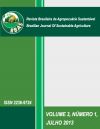PRODUCTION AND CHEMICAL COMPOSITION OF BRACHIARIA DECUMBENS CV. BASILISK IN SILVIPASTORAL SYSTEM UNDER DIFFERENT SPACING WITH EUCALYPTUS UROPHYLLA S.T. BLAKE
DOI:
https://doi.org/10.21206/rbas.v3i1.193Abstract
The objective of this study was to evaluate the effect of spacing on eucalyptus in silvopastoral system under production and chemical composition of Brachiaria decumbens. Four treatments were used, which were related to the three spaces planting of eucalyptus (3x2, 6x4 and 10x4m) plus the control treatment (no tree). The experimental design was randomized complete block with four treatments, four blocks and two repetitions per block, and the analysis was made by repeated measurements. It was found effects of treatment on the forage mass yielding and dry matter accumulation rate (DMAR). There were no effect of planting spacing either or leaf/stem ratio or CP percentage, NDF percentage and mineral percentage. Planting spacing of Eucalyptus urophylla affects both production and chemical composition of Brachiaria evaluated up to the 24 months.Downloads
Download data is not yet available.
Downloads
Published
2013-07-01
How to Cite
Raphael Pavesi Araujo, João Carlos de Carvalho Almeida, Saulo Alberto do Carmo Araújo, Everton Teixeira Ribeiro, Fábio Teixeira de Pádua, Carlos Augusto Brandão de Carvalho, Talita Pinheiro Bonaparte, Bruno Borges Deminicis, & Fábio Nunes Lista. (2013). PRODUCTION AND CHEMICAL COMPOSITION OF BRACHIARIA DECUMBENS CV. BASILISK IN SILVIPASTORAL SYSTEM UNDER DIFFERENT SPACING WITH EUCALYPTUS UROPHYLLA S.T. BLAKE. Brazilian Journal of Sustainable Agriculture, 3(1). https://doi.org/10.21206/rbas.v3i1.193
Issue
Section
Artigos
License
1. Proposta de Política para Periódicos de Acesso Livre
Autores que publicam nesta revista concordam com os seguintes termos:
Autores mantém os direitos autorais e concedem à revista o direito de primeira publicação, com o trabalho simultaneamente licenciado sob a Licença Creative Commons Attribution que permite o compartilhamento do trabalho com reconhecimento da autoria e publicação inicial nesta revista.












